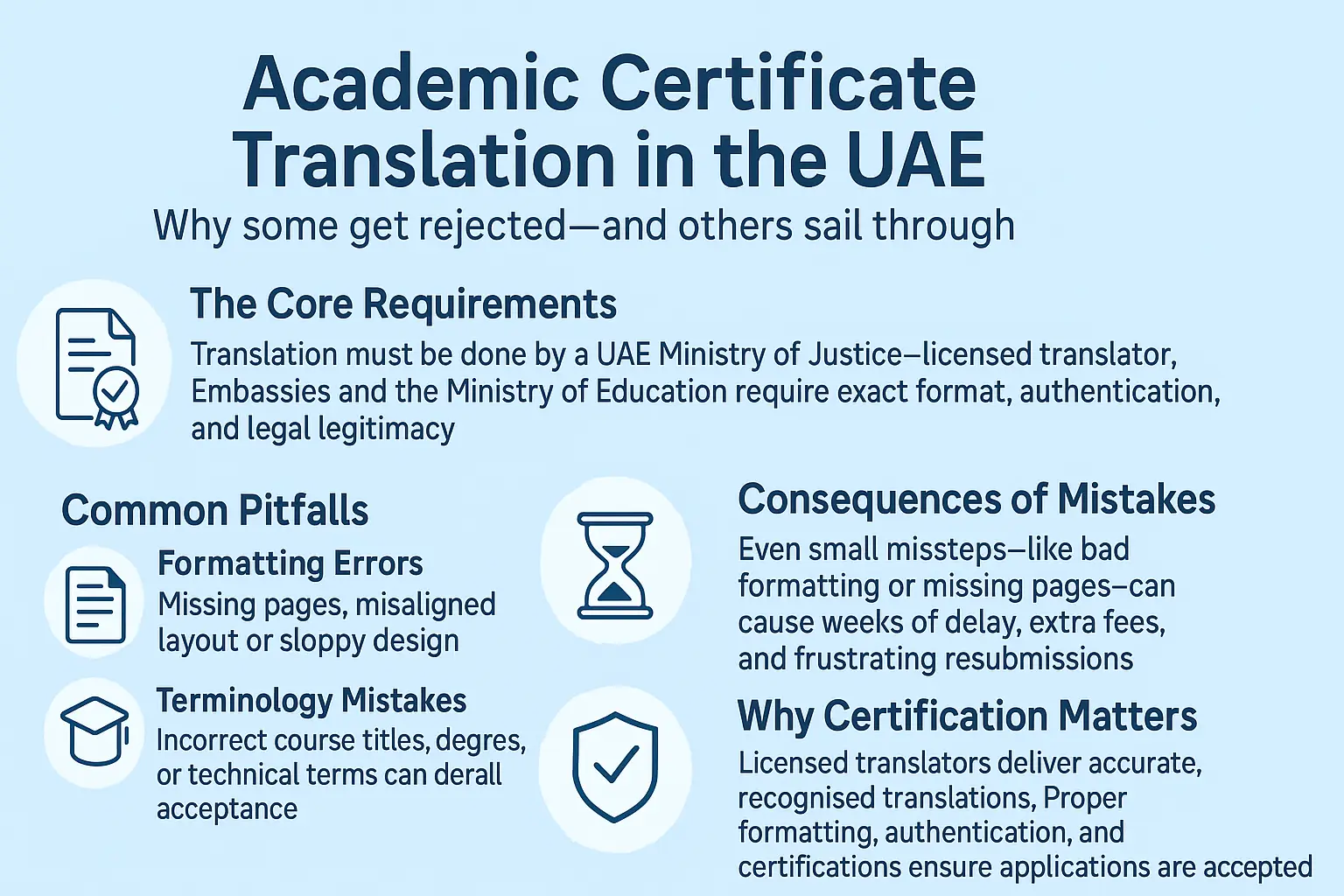
TL;DR: Getting academic certificates translated for use in the UAE is a legal and procedural process. Using an approved translator, following the Ministry of Education and embassy rules, matching the original format exactly, and avoiding common errors can make the difference between quick approval and frustrating delays.
Key Takeaways:
Studying abroad, applying for a job, or pursuing professional licensing in the UAE all require academic documents to pass through a certified translation process.
The process is far from a box-ticking exercise.
Government bodies apply strict checks, and even the smallest oversight can stall an application for weeks or see it rejected outright.
Many have watched their plans grind to a halt over something as small as a missing stamp, an incorrect date, or a poorly translated course title.
In some cases, this means resubmitting documents, paying additional fees, and facing weeks of unnecessary delay that could have been avoided with the right preparation from the start.

In the UAE, academic certificate translation involves much more than simply changing the language on a page.
Each translation must be carried out by a translator licensed by the UAE Ministry of Justice, as this official status gives the document legal recognition.
Without it, the Ministry of Education, embassies, and other authorities will reject the submission. Key points to keep in mind include:
The MOE applies detailed rules on how documents should be presented, how accurate the wording must be, and how every element should be authenticated.
Embassies often add their own requirements, which may include:
Overlooking any of these points can cause setbacks.
Small issues, such as a missing seal, an incorrect date, or a mistranslated course name, can result in an application being returned and the process having to start from scratch.
Authorities require the translated version to closely match the original document’s layout so that it is easy to verify and compare.
This means titles, sections, seals, and stamps should appear in the same positions and follow the same order as in the original.
Even the spacing and placement of signatures can be important for acceptance.
Academic terms need to reflect the terminology used in the local academic system. This includes the correct rendering of degree titles, course names, and institutional references.
A mistake here, such as translating a qualification into an incorrect equivalent, can confuse evaluators and lead to rejection.
Learn more about how translation errors can have serious consequences in the legal sector by reading Vision Translation’s article on legal translation challenges in Dubai courts.
Providing only part of a transcript or degree certificate almost always leads to an automatic rejection.
Authorities expect to see the complete set of documents, including all pages of the transcript or certificate, any back pages with seals, signatures, or notes, and supplementary pages that form part of the official record.
Leaving out even a single page can cause long delays and may require restarting the process from the beginning.
Translations completed by someone who is not approved by the UAE Ministry of Justice will not be accepted for official purposes. This is one of the leading causes of rejection.
It is essential to make sure the translator holds a valid MOJ licence, has solid experience with academic documents, and understands the formatting and terminology standards required by the receiving authority.
Every embassy applies its own set of rules, and these can differ quite a bit from one to another.
Some will only accept translations printed on official letterhead, while others may insist on extra notarisation, consular stamps, or particular types of attestation.
Overlooking these details can quickly lead to lost time, extra costs, and the frustration of having to resubmit documents.
For a deeper understanding of why accuracy is critical across different translation needs, especially in business, read Vision Translation’s insights on accurate legal contract translation in Dubai.
Translation timeframes can vary depending on several factors, and understanding these can help with planning. The most common factors include:
In many cases, a straightforward academic certificate can be translated and certified within one to three working days.
When extra steps like embassy or consular attestation are added, the process can take an additional week or longer, especially if the documents need to pass through several authorities for approval.
Some universities and authorities have started accepting electronic submissions of certified translations, which can save time and reduce paperwork.
Others, however, still require printed and physically stamped copies, so it is important to confirm the exact requirements with the requesting authority before relying on a digital version.
Even when submitted electronically, the translation must still be fully certified. This typically involves:
Following these steps helps ensure the document is accepted without question.

Vision Translation has been providing certified translation services in the UAE since 2006 and is approved by the UAE Ministry of Justice.
We focus on ensuring every academic certificate meets MOE and embassy requirements the first time.
Our process includes certified translators, strict compliance with formatting and authentication rules, quick turnaround, and secure handling of sensitive information.
With more than 100 language pairs, they serve students, professionals, and institutions across the UAE.
Vision Translation’s translation services in the UAE cover everything from academic paperwork to corporate contracts, with a focus on accuracy, confidentiality, and meeting official requirements.
Don’t risk delays or rejections because of a mistranslation or missing certification.
Contact Vision Translation today to get your academic certificate translated and certified by experts who know exactly what the UAE authorities expect.
Book your translation now and move forward with confidence.
